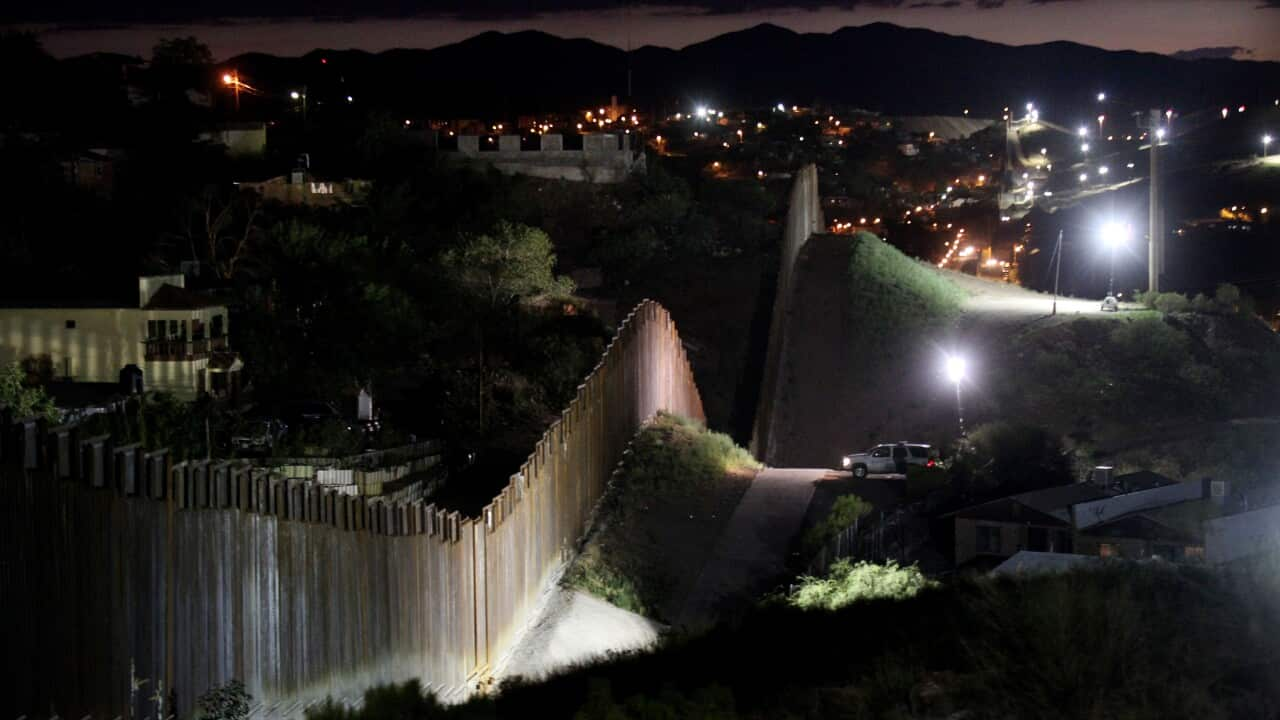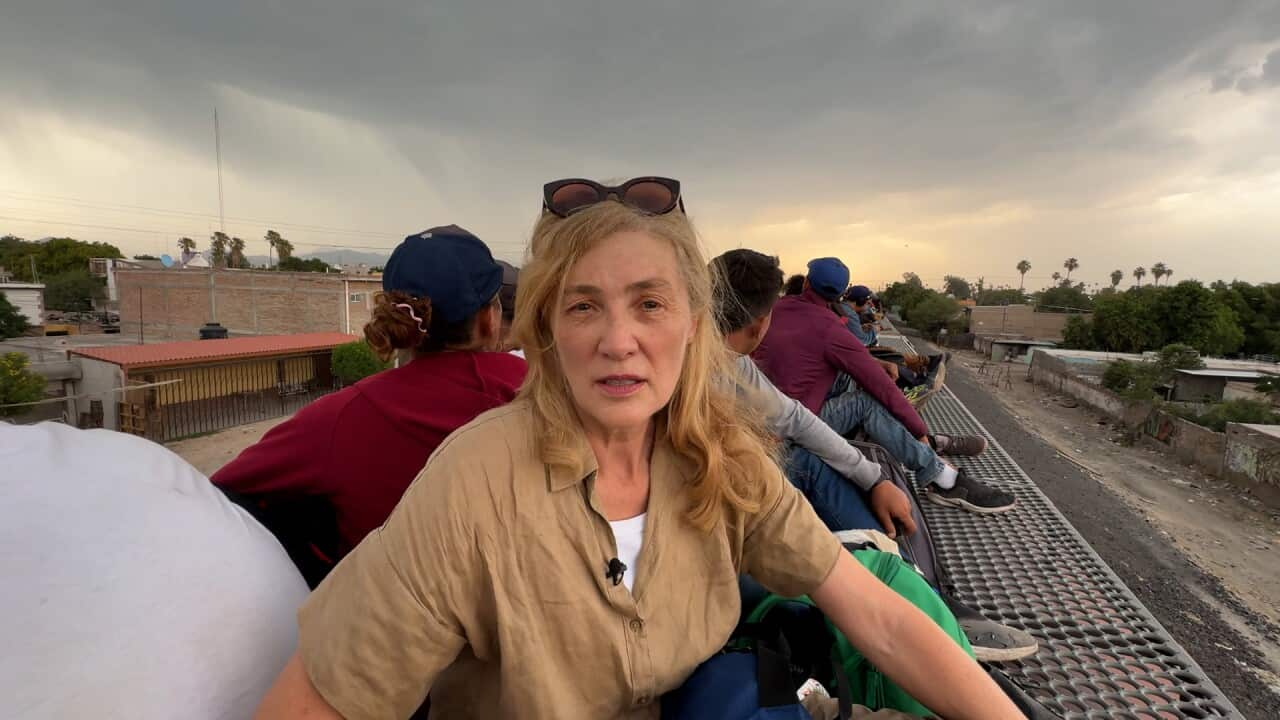Key Points
- The most popular land crossing for migrants entering the US is near Nogales in Arizona, where the border wall ends.
- US citizens are often on hand, volunteering to welcome them with a warm drink and a friendly smile.
- Border Patrol officers also attend the area regularly to process those who have arrived into the country.
It’s just past 5am and Randy Mayer is driving along rough dirt tracks at considerable speed, ascending and descending mountains we can’t see. In the desert, the dark is pitch black.
There’s no phone signal, no GPS. Fortunately, our driver knows every trail here by heart.
For 25 years, the local pastor has made this early morning journey to the US-Mexico border to provide aid to migrants who've crossed during the night.
"They’re fearful because they’ve only been in the United States for a few hours and they haven't met anybody, they’ve heard some people are good, some people are bad," he said.

Randy Mayer provides simple comforts to migrants who have just crossed the border, but cannot interfere with the procedures of US Border Patrol officers when they arrive. Source: SBS News / Ben Lewis
Eventually we reach the border wall and start to drive along it.
Migrants will have congregated at the most popular crossing point in this region, which not surprisingly, is where the wall ends.
As we pull up, silhouettes of people standing around a campfire come into view.
Mayer winds down his window and in Spanish, lets them know he’s here to help.
There are 35 people at this spot. They’re hungry, cold and tired, having crossed into the United States a few hours earlier.
There are women and several young children, asleep on their mothers, exhausted from their journey.

Groups of migrants arrive on a daily basis into the US where the wall on the border of Mexico ends. Source: SBS News / Ben Lewis
One man tells me he’s from Albania, a former soldier who had once served alongside US Forces in Iraq.
"When I saw the border, I was so happy," he said. "There were mafia in Mexico. The cartels. They take money, the police (do too)."
As we look back into Mexico, we see shadowy figures standing on top of a hill. Guides employed by the cartels keeping an eye on their human cargo.
"Most of the migrants will have probably been under the control of the cartels for five or six days," said Mayer, as he pours another hot chocolate.
Volunteers are careful to make sure the aid they provide migrants does not break the law. They can give them food, water, clothing and phone chargers, but they make it clear the Border Patrol will soon arrive to take them for processing and they can't intervene.
No-one will attempt to flee. The desert is deadly without proper provisions, so most will apply for asylum.
As the sun appears over the mountain peaks, the authorities arrive in pickup trucks. The women and children are taken first, then the fathers, then the single men.
A year ago, Mayer would often find two or three hundred migrants here every morning.

The authorities deal with the women and children first, taking them away for processing. Source: SBS News / Ben Lewis
US Border Patrol said encounters with migrants in September were 75 per cent lower than the same month last year.
Yet according to Republican presidential candidate Donald Trump, the situation is spiralling out of control. At rallies, he has accused vice president Kamala Harris of "letting in 20 million criminals".
That’s news to the people of Nogales.
The town is right on the border, with the fence running through it, separating Nogales, USA from Nogales, Mexico.
Retired teacher Sam Borrego has lived in Nogales her whole life and becomes animated when asked about former president Trump’s description of border communities as places of chaos and carnage.
"Of course he’s going to blow everything up. Do you see people jumping the fence going crazy? Of course not. This is a tranquil community. We go back and forth into Mexico. There is no problem."

Sam Borrego is a Nogales local and enjoys being able to easily come and go into Mexico. Source: SBS News / Ben Lewis
is holding a campaign rally, where immigration is a key topic.
"You know what Donald Trump thinks we ought to do?", he asks the crowd of several hundred.
"Build that wall, finish that wall and send illegal aliens back home, not to the United States of America."
The audience whoops with excitement. The mention of earns the biggest applause of the afternoon.
Cheering with the crowd is Susan Smith. Asked if the former president’s language regarding migrants bothers her, she replies: "Not a bit."
"I think it’s funny, I love it. He tells it like it is and that’s what I like about him."
Mayer finds that attitude difficult to comprehend.
"are trying to listen to middle America and middle America doesn’t know what’s happening. They’ve probably never met a migrant, they’ve never met someone whose father has been killed before their eyes and is fleeing for safety.
"A wall’s not going to resolve this."
As the last of the migrants are loaded into the back of a Border Patrol pickup and driven away, Mayer starts to pack up his things.
More migrants will arrive tomorrow, he and other volunteers will be back to help them, authorities will catch most if not all of them.
A never-ending game of cat and mouse for which no president has found a solution.












